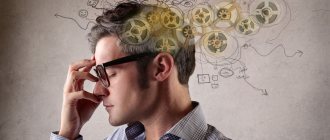An ambidextrous person is a person who is not characterized by the allocation of a leading hand to perform activities; the functioning of both hands is equally developed, actions are performed with the same strength, speed and accuracy. There are innate ambidexters and those who acquired this quality in the process of deliberate training of the skill. When observing the connection between the leading hand and the characteristics of brain development, a predominance in the development of the left hemisphere (logical) was revealed in right-handers, and the right (intuitive-sensing) hemisphere in left-handers. To schematically understand the concept of ambidextrous, who it is, we can suggest the statement that ambidextrous people are people with equally and harmoniously developed both hemispheres. The coordinated work of intuitive vision and logical analysis gives such people certain advantages over the majority.
At birth, any child has equal command of both hands, and only subsequently the educational system and parental instructions learns to perform actions with a certain hand; the level of mastery of both hands that ambidextrous children show significantly exceeds that of ordinary children.
But although this feature seems extremely positive, accompanying aspects may include distractibility, hyperactivity, difficulties in the learning process, rapid fatigue, increased moodiness, and excessive emotionality. Retraining and forcing one to do it with just one hand will not correct the situation, but will only worsen it; adjustments must be made in moments of outburst of emotions and with the inherent support when a person successfully performs tasks with both hands. After all, this is a unique gift that can be developed, trying to compensate for the negative accompanying features.
Ambidextrous – who is it?
An ambidextrous person is a person who can perform actions for a certain time, without discomfort and effort, with both hands
. Scientists believe that this feature can be either congenital or acquired.
Many people wonder, is it possible to become ambidextrous? Of course it is possible, although the chance remains small. The main thing is to work on developing your brain hemispheres. A person can independently change this psychological characteristic.
To figure out how to properly improve yourself, you need to know the essence of the concept of “ambidexterity.” Many people know the expression “leading hand.” In other words, for each person one of the hands functions more actively than the other. In the modern world, there are more people who often use their right hand (eating, holding objects, writing).
According to statistics, it is known that there are much fewer left-handers. But many believe that a large number of such people were retrained in childhood. They were forced to use their right hand as their dominant hand.
Experts say that the leading hand is a clear manifestation of a more developed hemisphere. Left-handers have a more developed right hemisphere, which is responsible for the intuitive, emotional content of everything around them, the integrity of perception, associative thinking, the perception of music and shades. And for right-handed people, the left hand is responsible for logic. They exhibit good calligraphy and reading abilities, memorizing accurate information and foreign languages.
Synesthesia in Psychology: Are synesthetes people with superpowers?
Great Ambidexters: Famous Personalities
By the way, many outstanding personalities were ambidextrous. Which, however, is not surprising.
Thus, Leonardo da Vinci, one of the most brilliant people in history, was fluent with both hands. Another outstanding ambidextrous genius is Nikola Tesla. There were quite a few “two-handed” rock musicians: Jimi Hendrix, Paul McCartney, and Ringo Starr. “Two-handed” are Russian tennis player Maria Sharapova and American actor Tom Cruise. Another similar actor is Keanu Reeves; Moreover, in addition to ambidexterity, he has a disorder such as dyslexia, which brought him some difficulties when studying at school.
Despite the fact that there are much fewer ambidextrous people, like left-handers, than right-handers, there is some data indicating that their number is growing in our time. This statement is actually controversial; after all, in earlier times there were a large number of “hidden” ambidexters and left-handers. Such people were forcibly taught to write with their right hand, but in everyday life they performed almost all other actions in the same way - either with their left hand or with both. In addition, today there is a tendency to “pump up” your brain in various ways, since people are sure that this will make it work much better; and one of these ways is to master ambidexterity.
The improvement of the position of left-handers and ambidextrous people in the modern world has also become possible thanks to digital technologies. Today, the ability to write with pen and paper is no longer such a sought-after skill as it used to be; the ability to quickly press keys and buttons is much more important, and here the presence of one or another leading hand does not play a role.
It is curious that along with ambidexterity, there is also the opposite phenomenon - ambisinistry; This is the name given to difficulty using both hands. Ambisinists find it difficult to perform a variety of actions, even the simplest ones. They are awkward. However, they can eliminate their problem as a result of training.
Ambidexterity - what is it?
Ambidextrous person writes with both hands simultaneously and separately
The definition of this concept states that there is a small percentage of people whose main “working” hand cannot be identified.
Ambidexterity is a fairly rare phenomenon that is characterized by equal development of both hemispheres of the brain. This manifests itself in the same functionality of both hands.
Ambidextrous people perform all tasks well with both their right and left hands. Both hemispheres of the brain of such people are equally developed.
Some geneticists believe that the LRRTM1
, but this fact has not yet been proven. Such people are characterized by the following characteristics:
- the accuracy of the actions performed in the same period of time is identical;
- This skill can be acquired by doing exercises, or you can be born with it.
What to do with an ambidextrous child
Parents and educators often make mistakes when working with ambidextrous people. The main mistake is putting pressure on the child to choose one driven hand. This should not be done; on the contrary, it is better to develop and encourage this quality.
Such children are more active, but they learn educational material faster than others, so they should be loaded with additional useful tasks. The child’s hyperreactivity should be directed in the right useful direction so that it is beneficial, otherwise the baby will get bored and begin to be capricious. The moods of ambidextrous children are more active and brighter than those of ordinary children.
The nervous system of ambidextrous people gets tired faster, so when working with such children, it is recommended to change their activities more often so that they rest.
In addition, you should not raise your voice or be rude to such a child. They will take it more personally than anyone else. Only thanks to a calm tone can you gain confidence in an ambidextrous child and cooperate with him.
Is ambidexterity an innate or acquired ability?
Many scientists believe that all newborn babies are ambidextrous.
What does it mean? It’s just that until the age of 4, children actively use both their left and right hands for various purposes. A person grows up in a society with established rules and norms, and his abilities are constantly directed in the right direction. We were all taught from an early age that you need to hold a spoon, write and draw with your right hand. As people grow older, their ability to use their left hand in work gradually fades away.
All sensible people understand that both hemispheres must be harmoniously developed. Therefore, it is necessary to develop the work of each hemisphere, and for this you need to know how to become ambidextrous.
Altruist - his character, motives, advantages and disadvantages
Ambidextrous child: recommendations for educators
Ambidextrous child, what does that mean? Such children have a number of characteristic features:
- They can write first with one hand, then with the other. Let's say his right hand is tired and he easily switches to his left.
- Take objects with each hand in turn. And this does not bring them any inconvenience.
To confirm the “diagnosis,” give the baby a hand in each hand. Ask him to write or draw something with both of them. If the drawing or inscription is not very different, the child is ambidextrous. How to behave with him?
First you need to understand that coping with hyperactivity will not be easy. In this case, it is useless to scold or shout. Better try to channel your irrepressible energy in the right direction.
Methods for developing ambidexterity
Ambidextrous child
There are many techniques that allow you to develop ambidexterity. They are developed by psychologists, scientists, and athletes. But not everyone wants to use these features for good purposes.
The well-known shooting from two pistols, a duel, does not lead to good. And the boxer’s ability to “work” with two fists at the same time cannot be called correct and honest.
But teachers who teach preschool children say that children often use both hands. They decide on the choice of leading hand later. Often this choice is influenced by parents or kindergarten teachers. After all, relatively recently, all ambidextrous and left-handed people were retrained. Of course, the child experienced discomfort in such a situation, but over time everything changed.
Now the approaches have changed. Children with ambidextrous tendencies are encouraged, helped and supported in every possible way, trying in various ways to stimulate the development of both hemispheres of the brain.
Ambidextrous people develop both hemispheres of their brain
The master's eye will do more than both hands. Benjamin Franklin
In addition, experts recommend that true right-handers do some exercises to develop their second hand. The tasks are simple at first glance, but for some they are very difficult to complete. It is necessary to dress a doll, draw with pencils or a brush, line up cubes, and play with a car. Afterwards, you can begin more complex exercises - writing, changing each hand in turn.
Remember, the main thing is a systematic and regular approach. Regular exercise to develop your second hand is the key to success.
Adults can also develop such abilities. You can perform routine tasks related to fine motor skills: comb your hair, brush your teeth.
You can also count how many fingers on each hand are used when typing on the keyboard. Often right-handed people use 1-2 fingers on their left hand. You can not only develop the second hemisphere, but also improve your typing. It is enough to open a special program and practice the correct placement of the hand on the keyboard. Such sites also clearly show how to move the hand correctly and which fingers should hit which keys.
Now you know how to develop ambidexterity. Let's move on...
Who are discretes? How to recognize them?
Ambidexterity pros and cons
Attitudes towards ambidexterity are quite diverse; initially, when identifying children with two-handed development, this category was considered inferior, and developmental disorders were noted. At the moment, this point of view is recognized as erroneous, and ambidexterity is considered a variant of normal development.
Of course, the beginnings of opportunities caused by ambidexterity can open up wide opportunities for development for a person, but the same development of two hemispheres in itself does not guarantee genius, just as one or another leading hemisphere does not provide it. A person can do an excellent job with both hands, but at the same time be quite mediocre and not show any talents, just as the development of either hemisphere does not increase the likelihood of specific achievements. In any case, the situation depends more on the person’s personal abilities and the efforts made. Although, with all other identical initial data and the same efforts made in terms of development, ambidexterity has a great chance of developing and realizing talents.
The benefits of developing this skill can be widely useful in solving everyday issues, when playing sports and at sports competitions (the uniqueness of some athletes lies in the ability to use both hands at once). Solving intellectual problems also has its own additional bonuses, since the ability of the brain to easily switch between hemispheres in its work allows you to find non-standard solutions, and helps keep intellectual-mnestic functions intact until old age.
The work of the brain, with alternating switching between hemispheres, and sometimes with their simultaneous operation, allows a person to increase the volume of long-term memory, increase the speed and quality of perception and processing of information. This feature of the psyche makes it possible to develop multitasking; an ambidextrous child can easily think about several problems at the same time, which was previously extremely rare and accompanied the genius of the individual. Potentially, an ambidextrous person is capable of new scientific discoveries much more than others.
But there are also negative aspects of this feature, which are associated with the choice of hand for writing or performing another skill. When entering a standard public school with its canonical education system, an ambidextrous child is more likely to be criticized and emotionally pressured than supported in the development of his characteristics. Due to the atypical way of assimilation and transformation of information, there may be a feeling of mental underdevelopment or the presence of deviations. With a competent approach, it turns out that it is worth changing the education system a little and such a child, who was previously considered lagging behind, shows results above average.
It is worth separately noting the emotional and psychological characteristics that manifest themselves in childhood and adolescence. Hyperactivity or attention deficit disorder, imbalance of the emotional background and inability to restrain emotions may be observed. The point here is not in character, but in the peculiarities of the functioning of the central nervous system, which, due to the activity of both hemispheres, experiences some overload. Also, the emotional sphere remains constantly on, i.e. in those moments when people with the dominant hemisphere can disconnect from their experiences, going into reasoning or work, the ambidexter continues to experience feelings in full force, while analyzing logically. This leads to nervous breakdowns, tense relationships with others, and increased activity. With age, a person learns to find his own ways of coping with such reactions; with the help of the environment, this happens faster.
Ability Benefits
A pencil in the hands of an ambidextrous man
All people can be divided into left-handed, right-handed and ambidextrous. The latter are quite rare. The harmonious development of the two hemispheres promotes a combination of logic and the ability to assess the situation as a whole. Intuitive perception allows you to take the right actions in emergency situations.
The peculiarity of ambidextrous people is also that they have clear, beautiful speech, complemented by emotional and figurative content. This combination makes you believe the speaker. Therefore, the world knows many famous ambidexters.
You should also remember the subtle perception of colors and musical sound. Therefore, such people often engage in creativity. They can quickly get used to the role, feeling and understanding their character, while simultaneously analyzing his actions and actions.
Ambidextrous people are people who have both hemispheres developed in approximately equal parts. They are successful and competitive.
Profession and character of a person: feedback
Ambidextrous mental potential
Ambidexterity is not just about arms. This feature determines the absence of a leading system in relation to any organ at all. Ambidextrous people do not have an aiming eye - since both aiming eyes, the pushing leg, have a better hearing ear, like right-handers or left-handers. Their active hemispheres switch from right to left with amazing speed, almost instantly. And the combination of subtle intuition and clear logic helps the ambidextrous person to very quickly grasp the essence of events and analyze information literally in a split second - and this, of course, is a plus. However, if you think about it, for the most part we try to separate feelings from reason - it’s easier there, but it’s almost impossible for an ambidextrous person to do this, as a result he experiences serious nervous overload. And this is a minus.
CONS of ambidexterity
People with developed both hemispheres also encounter problems.
Some scientists believe that the LRRTM1 gene may also indicate a tendency to develop schizophrenia. But this is an assumption. Many people believe that ambidextrous children start speaking late. But this fact has not been proven.
Research has also shown that the simultaneous functioning of the cerebral hemispheres can cause inattention in an ambidextrous child. “Attention deficit disorder” occurs due to the inability to concentrate on one activity. Therefore, such children are often tired and have headaches. They are constantly whiny and irritable. Such emotionality indicates active activity of the right hemisphere of the brain.
Growing up, this emotional activity collides with rationality and logic. As a result, the teenager experiences internal conflicts, the impermanence of the world, judgments, and choices.
Why is that? The older the child gets, the more “tired” the hemispheres of his brain become from working simultaneously. After all, they evaluate the world around them differently. But the vital energy of ambidextrous people allows them to reduce unnecessary stress by traveling and playing sports. It is important for such people to choose the right profession. It will help relieve excess worries.
Psychologically unstable character: should you be afraid?
How to properly raise an ambidextrous person?
The main difficulty faced by the mother and father of an ambidextrous child is his hyperactivity. There is no point in shouting at him and calling for calm. You need to try to keep it in sight and direct the crazy energy of the baby to something useful. Over time, the baby will learn self-control.
An ambidextrous child learns new material better, so he may be bored in kindergarten or school. An additional task will help parents and teachers here: make him not only draw a picture, but also come up with an interesting story for it. An ambidextrous person is a multitasking person.
When a child is excited or upset, you need to maintain a calm and even tone and avoid conflict. Your patience is a great indicator of how you can handle your emotions.
And, of course, never insist or put pressure on your child when choosing a leading hand. Help him, support him in word and deed, but there is no need to retrain him. It’s better to listen to your child: his unusual vision will open up new features of the world around you.
Famous and famous ambidexters
In fact, we know many great ambidexters.
- Gaius Julius Caesar.
Probably everyone knows that he is the most famous representative among ambidexters. This is rather an exception to the rule. After all, for men, performing multiple tasks at the same time is rare. They can do many things, but gradually, because they need to devote all their attention to only one thing. - Nikolai Tesla
, Nobel laureate, was also ambidextrous. Maybe it was this feature that caused him to conduct important research with electric current and magnetic fields. - Maria Sharapova
is ambidextrous; she can actively play with both her left and right hands. - Till Lindemann
. Multi-instrumentalist, member of the Rammstein group. - Tom Cruise
. It is his ambidexterity that allows him to quickly adapt to new roles on set. - Anna Odintsova
. A participant in the show “Amazing People”, who amazed everyone with her ability to write with both hands at the same time, as well as her excellent memory. - Leonardo da Vinci
, artist. I drew with both hands simultaneously and synchronously. - Also, many media reports that Putin is ambidextrous
.
Ambidexterity - psychological characteristics
Ambidexterity - what kind of person is this, and how does ambidexterity affect the brain? These questions are still largely open, because there are very few such people on planet Earth - only 1% of the total. The study of psychological characteristics is carried out mainly by observation, by taking an encephalogram and by analyzing handwriting by graphologists. Ambidexters have a contradictory nature, are neurasthenic and very touchy throughout their lives, but among them there are many brilliant, sensitive people who show the world something valuable: scientific discoveries, works of art.
Ambidexterity Test “Rotating Girl”
At this stage of reading the article, everyone will ask themselves the question: “Maybe such abilities are hidden in me?”
It's easy enough to check. There are several ways. The most popular is the ambidexterity test “ Rotating Girl”
«:
The first stage of this test is relaxation. You need to relax for 2 minutes and watch a special video that will show whether you are ambidextrous.
Author: (c) Nobuyuki Kayahara (Hiroshima, Japan), 2003
The “Spinning Girl” test allows you to draw conclusions about which hemispheres you have developed. Pay attention to which direction she is spinning:
- clockwise – the left hemisphere is developed;
- counterclockwise - right hemisphere.
- in different directions alternately - this means you can be ambidextrous.
Well, have you checked yourself? Are you ambidextrous?
Another way to determine signs of ambidexterity
All you need to do is take a regular white sheet of paper and 2 pens.
You must try to write the same word with both hands at the same time. The direction of the word does not matter. This is unlikely to happen right away. But if after a minute of effort you see a good result, then you are ambidextrous.
Facts about ambidextrous people
- Ambidextrous people make decisions faster.
- Such people can multitask easily.
- The IQ level of ambidextrous people is higher than that of left-handers and right-handers.
- Among the famous and most prominent ambidexters are Leonardo da Vince, Jimi Hendrix and Maria Sharapova.
- Ambidexterity can be congenital (1% of children) or acquired, developed independently.
- Ambidextrous people are hyperactive.
- Ambidextrous people can write the same word or draw the same shape with both hands at the same time.
Is a person naturally ambidextrous? (From the history of attitudes towards ambidexterity)
Share:
If you send the query “ambidexterity” to a search engine, then in addition to the dry and laconic article on Wikipedia in the first place, the list will open thousands of copywriting materials about amazing ambidextrous people, hundreds of tests to test yourself for “genius”, revealing your abilities for ambidexterity ; Yandex will offer more than two thousand videos on this topic; ambidextrous groups on social networks have thousands of participants. Among all these resources on the Internet, there are also schools that offer programs for “brain development” through teaching writing and drawing with the left hand. This is not a tribute to fashion, but rather a tradition coming from time immemorial, partly refracted under the influence of modern values and views. And by the way, it has nothing in common with modern scientific research.
Etymologically, the word “ambidextrous” means a person with two “right hands” - from the Latin dexter - right, dexterous, kind, happy. There is also the opposite concept - ambisinister - from the Latin sinister - left, evil; that is, this is a person who has two inept “left” hands. These concepts appeared much earlier than scientists had the opportunity to study the functional asymmetry of the brain, so it is not surprising that ambidexterity has always occupied the minds, first of all, of philosophers, thinkers and writers. And they, in turn, created a certain aura of mystery and even romance around this phenomenon, which has not dissipated to this day.
The motives of the thinkers of the past differ from the motives of folklore copywriting of the present only in their self-centeredness. If in the 19th century philosophers and publicists were looking for objects to put their ideas into practice, calling for a new way to educate and educate children, providing in the future a guarantee of the future happiness of their people or even all of humanity, now everyone is invited to discover or develop yourself a genius. If at the turn of the 20th century parents could convince their child that he was ambidextrous, only so that at school he could seem at least a little “normal” (left-handed people were then considered inferior), now a different trend is observed. Parents actively look for giftedness in their child and sometimes idolize him without limiting him at all. Whether this is good or bad, who knows... Time will tell. For now, let's go back in time and see how ideas about ambidexterity have developed in different eras.
Aristotle was one of the first to come to the conclusion that the assessment of the right hand as the best is largely conditional and based on custom. “It is within our power to have two right hands if we train ourselves to do so,” he wrote. Or maybe, the ancient philosophers thought, by raising children correctly, we could ensure that they learn to master both their left and right hands perfectly and, therefore, will be more adapted to life, more harmonious and talented? Plato in his “Laws” opposed the postulate of the difference between the right and left hand, saying that nurses and mothers make a person essentially “one-armed.” Is this really true? Is a person naturally ambidextrous? Is it possible to develop talents by training your non-dominant hand? Is a child who takes a pen in his right hand or in his left more capable than others?
"Classical" ambidexterity
Among the thinkers of the 18th and 19th centuries, there was a real movement that went against traditional ideas about the hierarchy of the right and left hands. Arguing that the difference between the right and left hand is due not to nature, but to the effect of social habits, philosophers proclaimed ambidexterity as a goal that every person should strive for. Jean-Jacques Rousseau, Xavier Bichat, Jacques Barthelemy Salgues, Joseph-Achille Comte unanimously wrote in their works that the formation of the habit of using one hand is not natural for nature and human physiology. Diderot goes further, saying that the “tyranny of prejudice” forces a person “from the first years of life to abandon the natural tendency to ambidexterity and sacrifice the left hand, which weakens from inactivity.”
This ideological trend paradoxically coexisted with the persecution and retraining of left-handers. True, here we were not talking about giving left-handed people the right to use their leading hand. Enlightenmentists sought to restore the rights of the left hand to right-handers, because they saw practical meaning in the formation of ambidexterity - the left hand should help a person survive and be more effective. And in order to give right-handed people the opportunity to develop their left hand, theorists proposed “tying the right hand” so that the left could receive “the vital force it lacks.” In these words we see a surprising coincidence with the educational and “punitive” methods of this era for retraining left-handed people to become right-handed. No matter how high the impulse to break free from the fetters that limit human development and adaptability, the thinkers of the 18th and 19th centuries were no different from the “dark”, in their opinion, teachers and preachers who proclaimed the “truth” of the right hand. As Pierre-Michel Bertrand eloquently writes about this socio-cultural phenomenon, “instead of leading a person to a shining future where he will be endowed with all kinds of talents, as a bunch of irresponsible utopians dream of, a culture of ambidexterity can give rise to an unprecedented social category - hidden right-handers."
"Romantic" super-ambidextrous
The “culture of ambidexterity” as a social movement originated in England when the writer and journalist Charles Reed wrote a series of articles in 1878 entitled “And Man Cometh.” “The new man will be ambidextrous,” he wrote, “not just right-handed or left-handed, but a man who has escaped from that birdcage of mothers, nurses and governesses with their pagan rhymes and stupid prejudices against the left hand; in general, this will be a physically harmonious person, as the Lord intended him.”
Charles Reed's successor, John Jackson, continued the search for a new man, "a man who enjoys the fullness of his being and reconciles, after many centuries of fruitless antagonism, the left and right hands, and respectively the left and right hemispheres of the brain, doubling his physical and intellectual potential." In 1900, the British Medical Journal called for "the universal adoption of ambidexterity." And in 1905, John Jackson founded the Cultural Ambidexterity Society. I will quote three rules and the motto of this society:
- Two perfect hands, equally skilled, are better than one.
- The left hand can and should be used with greater dexterity.
- Such a skill will bring many benefits to the individual and will be very useful to society.
Justice and equality to the left hand!
At the end of the 19th century, ambidexterity seemed to be beyond the good of the right hand and the evil of the left. This concept embodied the ideas of the “golden mean,” equality and moderation. And it is not surprising that the booming fashion for ambidexterity at the beginning of the 20th century forced school teachers to give children special exercises to develop both hands, writers to draw images of heroes dexterous with both hands, and directors to this day to make films in which brilliant scientists who are capable of simultaneously solve different problems on the board in front of an audience - one with the left hand, the other with the right.
However, like other utopias of the late 19th and early 20th centuries, the “egalitarian” utopia of ambidexterity was soon debunked by neurophysiologists who questioned the cult of the “two-armed” man. Scientists have come to a simple conclusion that it is asymmetry that distinguishes humans from animals, and “the pseudo-equality of ambidexterity is contrary to the laws of nature.” Indeed, if we turn to the National Corpus of Language (NCL), then semantically the word ambidexterity refers first of all to an animal, and then to a person with equally developed cerebral hemispheres “and, accordingly, with the same degree of mastery of the left and right hands (paws), without pronounced dominance of one of them.” Thus, ambidexterity, scientists believe, is a natural state of animals, as well as human infants, right up to the moment their sensorimotor preferences are determined.
All these conclusions seemed to go hand in hand with new ideas put forward by S. Freud and developed by C. Jung - about the “ambivalence of personality and culture”, which came close to the idea that a person does not need perfection and movement towards “extra” -states."
The very phenomenon of idealization of ambidexterity abroad is now called “the ambidextrity craze” (the madness of ambidexterity), and negative judgments were made quite sharply about the movement of John Jackson and like-minded people. For example, Crichton-Brown wrote in 1907 in his book Right-Handedness and Left-Banding: “In the very movement in the name of ambidexterity, I discern the same distorted judgment that constitutes a passing whim. Those who advocated ambidexterity previously promoted vegetarianism, but they go without hats, refuse vaccinations, or submit to any other absurdity.”
In the post-war years, ideas about the development of ambidexterity completely faded into the background, becoming nothing more than an anachronism. However, any fashion tends to come back. So in our time, ambidexterity has again begun to attract interest. At the beginning of the 21st century, new trends appeared in relation to ambidexterity - the desire to add supernaturalism and metaphysics. Ambidexterity began to be presented in tandem with esoteric concepts about “indigo” children, that is, children of a “new species”, ideas about the arrival of which flourished at the turn of the last and present centuries.
On the one hand, centuries pass, and admiration for ambidexterity and the desire to develop it still lives in the consciousness of humanity. And this is understandable - at all times, man has been distinguished by curiosity and sought to find ways to go beyond his capabilities, so the development of a second, less skillful hand has always seemed like something that opens up new horizons. On the other hand, at the moment you can find a lot of research on the topic of functional asymmetry of the brain. And although the phenomenon of ambidexterity, against the backdrop of more studied left-handedness, is not given much attention in neuropsychology, so it is sometimes the subject of anti-scientific controversy, you can still find objective data from modern research.
Ambidexterity - how to develop?
The development of ambidexterity suggests that a person begins to better use the creative potential inherent in him due to the formation of new neural connections and harmonization of the cerebral hemispheres. Right-handed people begin to develop intuitive abilities, and left-handed people sometimes lack logical, reasoned thinking, which right-handed people have in abundance. Training and exercises help both achieve their goals.
Ambidexterity - exercises
Developing ambidexterity in yourself is not that difficult. Discipline and daily practice will give results over time. Exercises for developing the second hand and synchronizing both hemispheres:
- perform normal daily work part of the time with the “weak” hand (right-handers - left, left-handers - right);
- juggling – helps to use both hands equally;
- embroidering alternately with both hands;
- learning to play musical instruments: piano, button accordion, accordion;
- ten-finger typing practice on a keyboard;
- simultaneous drawing on two sheets of paper: the right hand draws a square, the left hand draws a triangle;
- “mirror drawing” - drawing identical symbols, letters, figures with both hands.
Acquired and congenital ambidexterity
All children are born ambidextrous. But by the age of four they lose the ability to use both hands at the same time. This is largely due to parental influence, the intervention of doctors and teachers. The child is forced from all sides to use his right hand. With it he holds a spoon, a cup. One is taught to write with the right hand. As a result, such children turn out to be excellent performers in the future, but without creativity.
Acquired ambidexterity is the result of training a less developed hand (the return of the ability to use both hands well at the same time, lost in childhood).
Which hand is better?
Ambidexterity concerns different systems of the human body. Not only can he write with both hands, he has no such thing as a sighting eye, a pushing foot, or a finely discerning ear. This is a huge advantage .
But not all ambidextrous people write absolutely well with both hands : yes, they can do it, they change hands with ease, and do not get lost in case of replacement; but in a 50/50 percentage ratio, only 1% of people on the planet have both hands.
Therefore, there are no clear statistics : for example, that abidextrous people still have a more developed right hand, or left. But there is definitely some advantage to one of their hands (read – one of the hemispheres).
You can find a list of the best psychedelic films on our website.
Psychology of left-handers, right-handers and ambidextrous people:
Ambidexterity - reasons
Ambidexterity is often a congenital trait, occurring in 0.4% of people. The reasons for the appearance of ambidextrous people are not completely clear. Geneticist V. Geodakyan, the creator of the evolutionary theory of asymmetry of the brain and paired organs, conducted a huge amount of research, analyzed statistical data and found out that ambidexterity is characteristic of:
- premature babies;
- twins;
- weakened newborns.
Causes of congenital ambidexterity:
- Genetic. The presence of the LRRTM1 gene, which is also responsible for the development of schizophrenia (there are more ambidextrous people among schizophrenics).
- During fetal development, the left hemisphere at some point begins to develop faster and more intensely than the right. Intrauterine hypoxia or other unfavorable factors affecting the fetus cause inhibition of the development of the left hemisphere and such a baby is born left-handed or ambidextrous.











